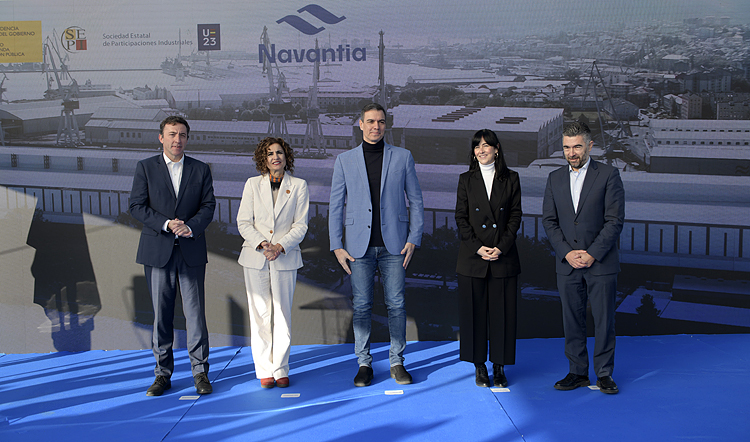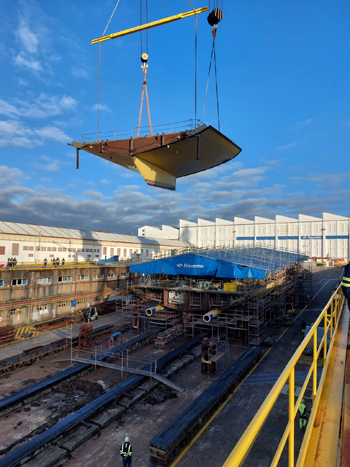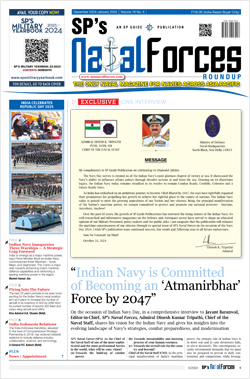INDIAN ARMED FORCES CHIEFS ON OUR RELENTLESS AND FOCUSED PUBLISHING EFFORTS

The insightful articles, inspiring narrations and analytical perspectives presented by the Editorial Team, establish an alluring connect with the reader. My compliments and best wishes to SP Guide Publications.

"Over the past 60 years, the growth of SP Guide Publications has mirrored the rising stature of Indian Navy. Its well-researched and informative magazines on Defence and Aerospace sector have served to shape an educated opinion of our military personnel, policy makers and the public alike. I wish SP's Publication team continued success, fair winds and following seas in all future endeavour!"

Since, its inception in 1964, SP Guide Publications has consistently demonstrated commitment to high-quality journalism in the aerospace and defence sectors, earning a well-deserved reputation as Asia's largest media house in this domain. I wish SP Guide Publications continued success in its pursuit of excellence.
- MoD initiates comprehensive review of Defence Acquisition Procedure 2020, pushes for defence reforms
- G7: The Swansong
- Kalinga Connect: South Asia to Polynesia
- Advanced MRSAM for India for a greater firepower
- Must Credit DRDO for Operation Sindoor, now what is next for defence R&D?
- Operation Sindoor | Day 2 DGMOs Briefing
- Operation Sindoor: Resolute yet Restrained
Navantia's F-110 programme ahead of schedule
- The first steel of the F-112 has been cut in Navantia’s shipyard at Ría de Ferrol (A Coruña, Spain)
- A total of 24 out of the 33 blocks of the F-111 are already under construction and assembly
- Navantia sets the fifth block of the F-111 on the slipway


Navantia has started the construction process of the second frigate of the F-110 class for the Spanish Navy, thus confirming the speeding up of this programme valued at €4.325 million.
The cut of the first steel of the F-112 took place on December 16, 2023 at Navantia's shipyard in Ferrol (A Coruña, Spain), in the presence of the President of the Spanish Government, Pedro Sánchez; the Fourth Vice-President of the Spanish Government and Minister of Finance and Public Function, María Jesús Montero; the President of SEPI, Belén Gualda and the President of Navantia, Ricardo Domínguez.
The programme -whose execution order was signed in 2019- foresees the construction of five frigates. The start of production of the F-112 is four months ahead of schedule, thanks to the high degree of maturity of the design and the progress of engineering work.
The first frigate of the series, the F-111, under construction since 2022, has been also sped up and has gained momentum with a total of 24 out of the 33 blocks (compared to the 18 planned in the schedule) currently in various stages of construction and assembly. Of these, five blocks are already on the slipway, after the fifth of these blocks was set in place on December 18.Moreover, terms of procurement, 98% of the program's equipment has already been acquired, with materials reaching 95% for the F-111 and 70% for the F-112.
The Spanish Navy's F-110 frigates are multi-purpose escort vessels, with anti-aircraft, anti-surface and anti-submarine capabilities that will enable them to perform their force protection and naval projection functions. These ships, which are intended to operate in combination with other units, make them versatile platforms that can perform maritime security-related functions.
The design of this new frigate includes advanced technological features, such as an integrated mast with different sensor and antenna solutions, a multi-mission space that expands the ship's capabilities in all defence segments and a new hybrid propulsion plant, more efficient and silent, giving the ship great versatility. The frigates will be equipped with the Spanish combat system, SCOMBA, developed by Navantia Systems.
BLOCK FACTORY
The F-110 programme is the main driver of Navantia's Digital Transformation Plan in Ferrol (A Coruña, Spain), which will involve the implementation of a new digital ecosystem that will renew the production centres. In the case of Ferrol’s shipyard, it will be materialised through the construction of a new digital block factory with an investment of €110 million (the largest investment made in a shipyard in Spain in this century).
The factory, which first stone was laid on December 16, will be a fully digitalised, automated and robotised plant, including advanced technology machinery, which guarantees product optimisation, versatility and reduced delivery times. In this new open unit manufacturing line, the traditional welding process is replaced by hybrid laser technology, substantially improving performance and minimising distortions.
All of this will boost the region of Ferrol, placing it on the map of excellence in the design and manufacture of frigates worldwide thanks to an infrastructure of these characteristics, fully digitised, automated and robotised, including advanced technology machinery.
On the other hand, the F-110 programme has an important impact on the supply chain, with more than 500 Spanish companies participating in the programme and a significant generation of employment of up to 9,000 people, including the generation of induced employment.
DIGITAL TWIN
The F-110 frigate will be a smart ship, the first Spanish naval programme designed to have a Digital Twin: a virtual replica of the ship that constantly receives information from the vessel, data permanently supplied by a network of sensors distributed throughout the ship, constituting a cyber-physical system that through the use of behavioural models and technologies such as Cloud Computing, Machine Learning and the Internet of Things (IoT) allows to support its maintenance and operation even thousands of miles away through the Digital Twin deployed ashore.
The Digital Twin is complemented by an Integrated Services System (ISS), developed along with the Universities of Vigo and Coruña (Galicia, Spain), which will provide the ship with integrated sensors in its light points, substantially reducing its wiring. The F-110 will also have 3D printers on board for the manufacture of spare parts.
These will be the first ships in the fleet to have an integrated cybersecurity system to protect the vessels against increasing cyberthreats. This will enable the ship to have a reduced crew complement for operation, which will result in improved habitability.





